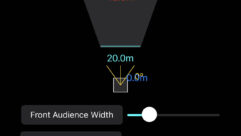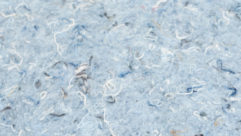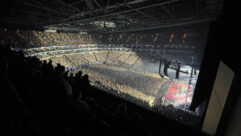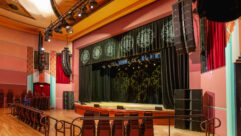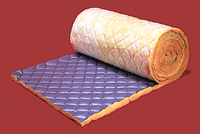

Acoustics/Room Tuning
Apr 8, 2010 12:00 PM,
By Bob McCarthy
You can tune a guitar or a radio, but you can’t tune a room. The knob is just too darn big! Nonetheless, the term “tuning the room” has been adopted to describe the tools and techniques used to neutralize a listening space and its installed loudspeaker system. The basic concept of room tuning is to remove or modify the types of reflections that leave an overpowering imprint on the material heard there and leave enough reflective properties in the room to prevent the unnatural feeling of being overly dry. The products in our roundup here represent some of the key items of ready-made room-treatment products and the analysis equipment used to measure their effects.
We will divide the acoustical side of our inventory into three basic categories: absorbers, tuned resonators, and diffusers. Many of the vendors in this field cross over between more than one of these categories.
Absorbers
Let’s start with absorbers. This is not the most dynamic sector of manufacturing. Let’s face it: Fiberglass is not going digital any time soon, so don’t expect epoch-changing advances with each passing year. On the positive side, these products are not obsolete upon delivery. There are some interesting recent developments, however, in terms of environmental impact. Acoustic absorption is going green and working to reduce its carbon footprint.
Acoustics First StratiQuilt fiberglass rolls
In addition to a wide array of fiberglass panels, the folks at Acoustics First offer highly absorptive quilts. The StratiQuilt fiberglass rolls are 4’x50’ (WxL) that can be edge-bound as needed (with the help of your local quilting club). This lightweight, semiflexible, easy-to-handle material is a vinyl-coated, gray-colored fiberglass-facing cloth quilted to a supporting 2lbs.-per-cubic-foot-density fiberglass. These portable barriers/absorbers can provide up to 21dBA noise reduction. One of the many practical applications for this is hung behind a flying loudspeaker array to control the rear lobes and reduce reverberation.

Acoustical Solutions EcoSorpt
Returning to our green revolution, we find the Acoustical Solutions’ EcoSorpt acoustical wall panels. These high-performance absorbers, made with recycled cotton products, contain at least 85 percent post-industrial recycled content, making them a natural for LEED-certified projects. The absorption coefficients at 2kHz and below are comparable to traditional fabric-covered fiberglass panels, with lower environmental impact and carbon footprint in their manufacture and superior recyclability when they are no longer in use. These products come in two densities: 3lbs. and 6lbs. per square foot in the 1in. thickness. There is also a 3lb. version at 2in. thickness.
Auralex Acoustics has introduced the fabric-wrapped low-emission ELite ProPanel, manufactured without formaldehyde and phenol and using 35 percent post-consumer recycled material. They emit a lower amount of volatile organic compounds (VOCs), achieving both Greenguard Indoor Air Quality and Children & School certifications as well as LEED eligibility. These innovations come without sacrificing absorption capability. The standard 1in.- and 2in.-thick Elite ProPanels are available in 2’x2’ and 2’x4’ shapes in a variety of fabric colors (not just green).
RPG has also gone green (and brown) with its Ecose Technology, which has also reduced the amount of petrochemicals traditionally used in this class of absorption products. The absorbent areas of these panels are notable for their distinctive brown color—the natural color of fiberglass manufactured by the Ecose process. The panels are Greenguard- and LEED-credit-approved and are fabricated so as not to contain phenol, formaldehyde, or acrylics. This new technology is available in RPG’s line of absorber panels and the hybrid diffuser/absorber Binary Amplitude Diffsorbor (BAD) panel product line (see the “Diffusers” section below for more on BAD).
Acoustics/Room Tuning
Apr 8, 2010 12:00 PM,
By Bob McCarthy
Tuned absorbers/resonators
There are other options beyond the broadband drying of the room that results from panel absorbers. Fiberglass and soft-foam absorber systems are much more effective as frequency rises, leaving the room with much shorter decays in the HF range. Tuned devices can be targeted for particular ranges, most notably the low frequencies, enabling for a more balanced spectrum in the reverberant decay characteristic.

Acoustic Sciences Tube Trap
The original name (since Helmholtz never developed a commercial line) in commercially available tuned absorbers is the Tube Trap . These devices, manufactured by Acoustic Sciences (ASC), look like furniture from a Stanley Kubrick film. Cylinders of various lengths and radii can be placed near walls and corners to neutralize a target frequency range. The cylinders contain a mixture of diffractive and absorptive elements, thereby creating a tuned antiresonator for the low-frequency range and diffraction and absorption above that. In addition to the full cylinders, the company now offers half-rounds and quarter-rounds, allowing for more options in placement, particularly for corners.

RealTraps MegaTrap
Another player in trapping technology is RealTraps. The company combines the direct sound absorptive properties of a traditional panel absorber with the flatpanel resonating-membrane absorber into a single device. The combination extends the range of action down in frequency to create an even spectrum of absorption. The newest entry in the line is the MegaTrap, a corner-placed limp-mass membrane unit that is nearly 3ft. wide. It is claimed to absorb more and to lower frequencies than any other absorber. MegaTraps have the aesthetic advantage of appearing to be simple fabric panel and are available with the front fabric in white, wheat, gray, and black colors.

Auralex Acoustics MegaLENRD
Foam absorbers placed in the corner can also create a bass trap. Auralex Acoustics has a mega product of its own: the MegaLENRD bass trap. For the acronym-impaired, LENRD stands for “low-end node-reduction device,” “node” being a term related to fixed-location resonance activity of low frequencies in a room. Corners are the most critical location for nodal control. The MegaLENRD is the largest of this family of easy-to-install foam corner absorbers and is suitable for studio as well as larger-scale applications where visible foam is acceptable.
Diffusers
The third major classification of room acoustic treatment products is the diffuser. These devices aim to scatter the sound from their complex faceted surfaces to create a more randomized reverberation character. One can visualize the complexities of the ornate plaster walls in traditional concert halls and realize the acoustic value of the art was in its quality of diffusion. For those of us without budget or desire for plaster artwork, there is a great variety of modern products mathematically engineered to provide controlled scatter. A well-designed space can blend absorption and diffusion products effectively to create a room with sufficient reverberation, free from flutter echoes (detectible and consistently time-separated reflections). Next, we will look at some exclusively diffusive products and some that are hybrids of absorption and diffusion.
RPG has developed the Binary Amplitude Diffsorbor (BAD): a diffusing absorber that is flat in appearance and no deeper than a purely absorptive panel. A BAD panel simultaneously provides uniform diffusion at high- and midband frequencies and then pure absorption below the diffusive range. The energy that is not diffused is absorbed.
The finished appearance of the panel matches a traditional fabric-covered absorption panel, yet these units contain an intermediate layer between the fabric and fiberglass. The diffraction is carried out by a uniquely patterned perforated rigid panel that scatters the highs and allows the lows to pass through to the absorber behind. The binary hole pattern resembles a Lite-Brite in appearance, but it is mathematically calculated to provide a flat power spectrum of diffuse energy. These panels can flush mount to walls or ceilings with a wide assortment of fabrics available.

Acoustics First Art Diffusor
Acoustics First has developed the Art Diffusor, a patented series of two-dimensional binary array diffusers. The diffusion range of the Art Diffusor is extended by its unique angled end caps to further control detectible specular reflections above 4kHz. The various models differ in their depth and material. As the depth increases from 2in. to 9in., the frequency span where diffusive qualities dominate ranges from 2 octaves to 5 octaves. They are available in furniture-grade wood or expanded polystyrene.
The AlphaSorb sound diffusers by Acoustical Solutions discreetly provide diffusion while having the appearance of a fabric-covered wall or ceiling panel. Behind the fabric are specially molded plastic diffusers designed to scatter or disperse acoustic energy. They are 2in. thick and available in 2’x2’, 2’x4’, and 4’x4’ sizes and a variety of colors. Users can also create the mixed acoustical effects of diffusion and absorption by combining the AlphaSorb sound diffusers with a pure absorber, the visually matched 2in.-thick AlphaSorb acoustical wall panels.
Acoustics/Room Tuning
Apr 8, 2010 12:00 PM,
By Bob McCarthy
Analysis Tools
Purchasing and installing absorption and diffusion devices are middle steps in the big picture of tuning the room. Before these steps, we must ascertain the needs, and after them, quantify their effect. For installations of an existing space, an acoustic analyzer will be key to the before and after. The analyzer must be capable of seeing the details of diffuse reflection patterns, reverberation decay timing, and the strength of the direct sound, among many other things. Let’s look at some of the spectral analysis tools used to evaluate the room and finally to tune the loudspeakers in the room.
Related Links

Leading acoustician Mark Holden of JaffeHolden has been instrumental in the renovation process at Lincoln Center…

Pro Contracting Apps for Your iPhone
Sooner or later, you gotta start regarding Apple’s iPhone/iPod Touch as a serious platform…

Until the past few years, technology advances in architectural loudspeakers were aimed primarily at the freestanding and exterior-mounted models where designers had a more free hand, but new materials and steerable tweeters have made their way into the ceiling loudspeaker market with impressive results…
EASERA (Electronic and Acoustic System Evaluation and Response Analysis), a product of Renkus-Heinz, brings into a laptop PC with a soundcard, a suite of acoustical analysis tools that a few years ago would have filled several equipment racks. Complex analysis of room acoustic functions can be gathered via a variety of stimulus signals including time-delay spectrometry, a sweep, a maximum-length sequence, or a noise-excitation signal. The data can then be used immediately or post-processed off site into a huge variety of computations too large for this article.
For live sound applications, the sister program SysTune provides dual-channel analysis of the system with all of the data relevant to equalization and sound system optimization, including the capability to continue the tuning with music as the source signal.
Measuring Room Acoustics
The 7841 DIRAC system, distributed by Brüel & Kjær, is an acoustics measurement software tool developed by Acoustics Engineering. DIRAC room acoustics software type 7841 uses impulse responses for measuring a wide range of room acoustical parameters including reverberation time, early decay rate, clarity, intelligibility, and much more.
Other options of excitation signal include the internally generated maximum-length sequence (MLS) or sweep signals through a loudspeaker sound source. Survey measurements are easily carried out using a small impulsive sound source, such as a blank pistol or even a balloon.
Meyer Sound’s SIM 3 is a comprehensive multichannel sound system/room analysis system designed for realtime optimization of installed loudspeaker systems. The system interfaces directly into the loudspeaker system’s signal processing to provide detailed info to find the best delay, level, and equalization settings for optimum response in the room. The system has configurations appropriate for all sizes from studios to stadiums.
Rational Acoustics is taking orders for v.7, the next generation of Smaart. The new version features enhanced stability, higher resolution, and multichannel capability far beyond the previous versions. Smaart has room acoustic analysis capabilities as well as the realtime features required for live sound tunings.


